The Trans* Symbology Almanac
Scope and purpose #
The purpose of this project is to look at work (primarily still images) created by transgender and gender-diverse[1] artists in order to identify common visual themes. Across various artistic disciplines and diverse marginalized communities, a visual vocabulary of sorts often develops. This may be through a conscious effort to encode information or evoke a different meaning or emotion in certain viewers, while traveling under the radar of the larger public. It may also evolve from homages to other artists or works. In many cases, however, I believe it is a kind of convergent evolution— artists trying to express complex ideas and emotions and pulling imagery from various places in a shared cultural landscape.
Drawing from a pool of artistic work in established online archives of Queer art, as well as seeking contributors from self-identified trans* artists, this project will attempt to establish visual connections between otherwise unconnected work. The goal of this project is not to decode or translate the visual symbols used by trans* artists, it is simply to identify them and create a navigational layer allowing users to experience the collected work in a different way— to tap into the “collective unconscious” that underlays trans* existence, explore the ways that artists give form to concepts that are often abstract to those who do not experience them, and to catalog (where possible) the visual shorthand for those experiences.
The primary audience for this project is other trans* people— artists, academics, or any other trans* person who is interested in taking a look at the way themes of body dysphoria/euphoria, transition, and general trans existence are represented in visual media. The secondary audience is cisgender artists and educators who seek to experience and learn from the work of their trans* peers.
Limitations and scalability #
While the focus of this project at present is work by artists from the past ~20 years, with an additional focus on artists who are producing work that at some point takes digital form, given more time and resources the scope could easily expand further back in time. With additional time, appropriate webhosting, and people, this project could also extend to other forms of visual art, including video/animation, text-based work, and video games/visual novels.
This project is dependent on the cooperation of individual artists, in addition to archival institutions. Proper care must be taken to ensure that the rights of the artists are respected. Creators must retain all rights to their work and have the right to have their work removed upon request, with no limitations.
Project overview and methodology #
This project serves two purposes. The first is as a digital archive of art by trans* creators. The second is as a tool for exploring common visual themes presented in unconnected works by members of a marginalized community. The development process, therefore, can also be broken down into two phases— development of the base archive, and development of this “exploration” layer.
Ideally, in order to be able to actually establish broad themes or trends, the collection would start with at least approximately 150-200 assets.
Building the almanac #
| 1. Base Archive Development | ||
|---|---|---|
| Goal: to develop a standalone digital archive of work by trans* creators, within the constraints of this project’s scope Minimum viable product: • Website must meet Web Content Accessibility Guidelines (WCAG) wherever possible (if it does not seem possible, reevaluate the approach or concept to attempt to meet) • Responsive site, small load times • Free text search, advanced search query builder, full intext of all searchable terms |
||
| Asset acquisition | ||
| Create a list of appropriate sources of assets for the collection (individual creators, existing collections/archives) | Secure permission to reproduce the requested assets | Receive assets via file transfer (Dropbox or other secure file share); ideally as high-resolution digital images with accompanying metadata records when possible |
| Creation of surrogate records | ||
| • Prior to any file organization or record creation, guidelines for naming conventions, file formats, dimensions and other technical specifications must be established • A Digital Asset Management (DAM) platform should be used for the organization of assets and creation/cataloging of metadata • For metadata, the current recommendation is to use the Library of Congress’ Metadata Object Description Schema (MODS), as it provides flexibility and generally approachable for individuals without specialized metadata training |
||
| Images | ||
| If high-resolution digital images have been provided, standardize naming conventions and file format (web-appropriate, jpeg or png; additional versioning for responsive layouts or fail-over file types can be handled during website buildout) | If no digital images exist (physical assets were provided), create high-resolution scans or photographs | |
| Metadata | ||
| Generate metadata for all assets, to include at minimum the creator’s name, the title of the work, and the date created/published | If metadata exists, convert if necessary to ensure a consistent standard across the project | Where needed, create metadata from scratch |
| Website development | ||
| Note: this section is only intended as a broad overview of website development; appropriate technology stack and hosting TBD | ||
| Secure hosting; database creation; backend development | UX/UI design; frontend site development | User testing; bug fixes |
While the website development phase of the project is underway, production can begin on creating the necessary additional content for the exploration layer.
| 2. Exploration layer development | ||
|---|---|---|
| Asset review | ||
| Sort assets into categories based on the most literal topic (autobiographical content, fan art, portraits, etc.)— when possible, these topics should come from the creator of the asset | Establish additional themes throughout the entire collection; these may include: • transition (in a literal or metaphorical sense, or in a sense of medical transition) • family, loss, gender dysphoria/gender euphoria, other emotional themes • repeated visual motifs (particular plants or animals, illustrations or stylizations of scars, settings/locations, specific characters from pop culture, etc.) |
Common color schemes (use of the trans* pride flag as a palate, etc.) • To identify and enable navigation by color, the Python Imaging Library (PIL) can be leveraged to analyze images and extract RGB values which can then be used to create color swatches for navigation |
A separate index for terms associated with these visuals or themes would then be created. Navigation via this “exploration layer” could be enabled through traditional free text search, navigation via an index, or through use of a color picker or histogram. Image maps could be used to create hotspots on the assets themselves, allowing a user to mouse over the image and reveal if a section has been “tagged” with a subject. Clicking through would then allow the user to navigate a gallery showing the sections of other assets with the same tag.
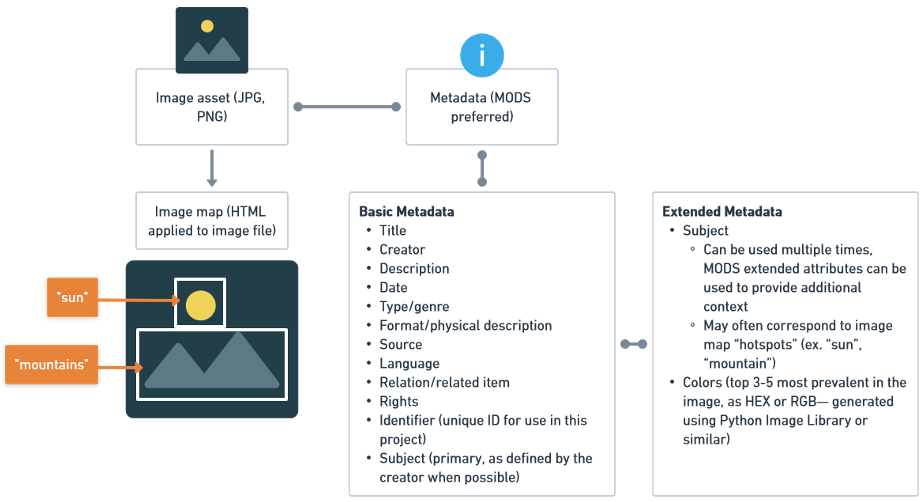 |
A basic example of navigation by image map:
 |
As an example, these three images would be related because they show stylized representations of top surgery scars:
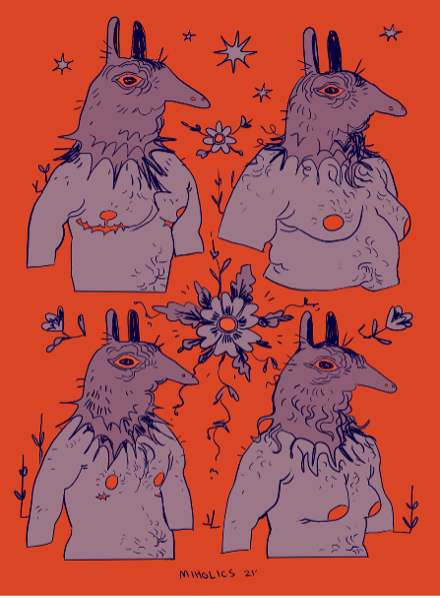 |
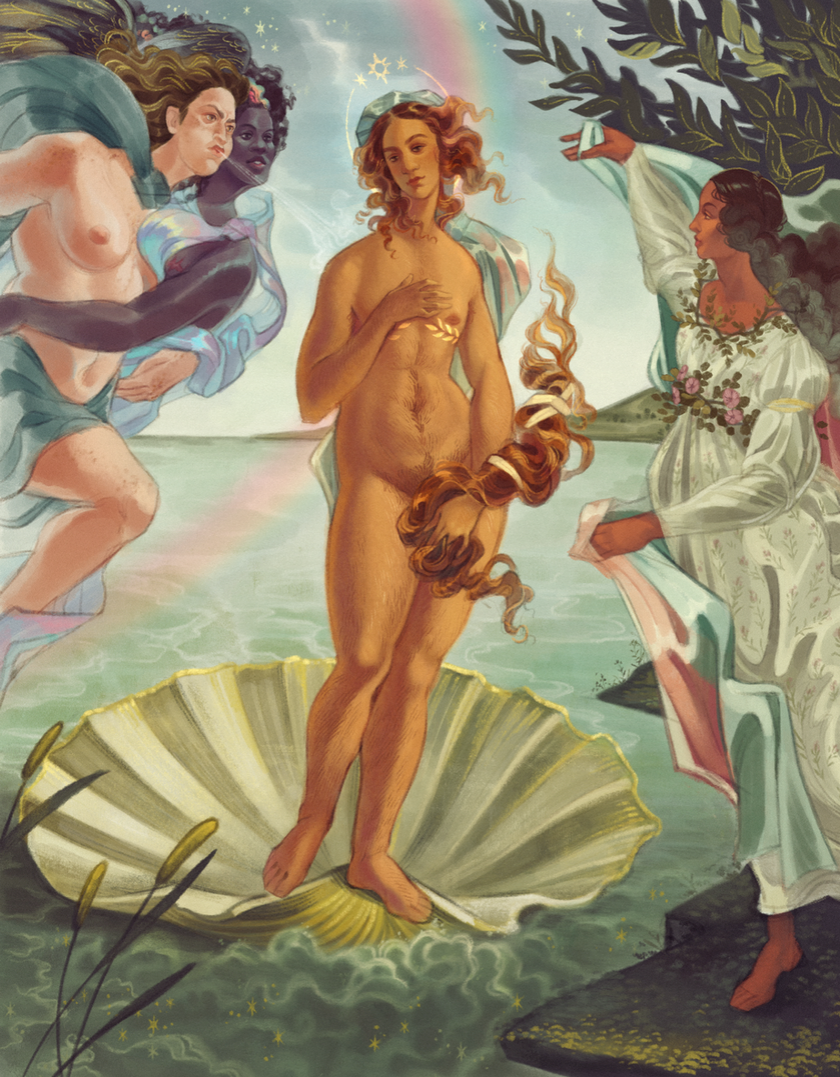 |
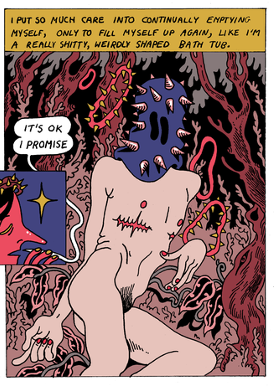 |
| Transmasculine Bodies, Julian Miholics | Classics, Marlowe Lune | Really Shitty Bathtub, leo fox |
Similar or related works #
Archives #
The Digital Transgender Archive has an art collection, comprised of works from contributions from a variety of institutions including the Cork LGBT Archive and Yale University Libraries. However, this collection is focused on historical depictions of gender diversity in art, with the bulk of the collection being work from the 1700-1800s.
Queer.Archive.Work is a nonprofit library and publishing studio in Providence, Rhode Island. They have a non-circulating library of books, zines, and other work by Queer creators. While the non-circulating library contains work by contemporary artists, Queer.Archive.Work also hosts a Download Library of PDFs of “significant and difficult-to-find publications from the last fifty years, focusing on urgency, radicality, and liberation,” including issues of Adam’s Word and GenderTrash.
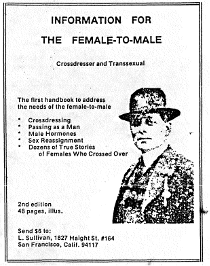 |
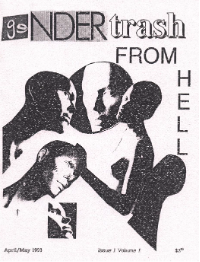 |
Research #
A 2020 dissertation by Ace Lehner at the University of California – Santa Cruz discusses the ways that “trans and non-binary self-representations are reshaping identity categories and challenging and augmenting contemporary theory and imaging practice” in the field of photography, and works towards establishing Trans Visual Studies as a field. (Lehner, 2020, p. viii)
Data visualization #
Looking at data visualization, The Pudding has an excellent collection of visualizations, many of which use data pulled from images. In the article Colorism in High Fashion, the authors, designers, and developers used Python to analyze the faces of Vogue cover models and group them by skin tone.
Nicholas Rougeux’s digital recreation of/expansion on Werner’s Nomenclature of Colours is another interesting example of applying new methods of navigation to existing artwork. The project allows users to browse all 110 color swatches from the original guidebook, and connects the swatches to each other by showing which colors are components of others.
Other online gathering places #
Broadly speaking, Tumblr has been a gathering place for Queer and trans* digital artists since its launch in 2007. Despite fluctuations in popularity, there is still a wealth of art by trans* creators on Tumblr, especially work dedicated to various fandoms.
Many trans* artists, game designers, and authors are also active on Twitter and other social media platforms.
About me #
I am a current graduate student at Rutgers School of Communication and Information, in the Master of Information program, with a focus on archives and preservation. My prior educational background is in digital art and animation, and I am a practicing digital and analog artist.
I am also transgender. My relationship to my body and the societal trappings of gender roles is inescapable in the ways that I interact with the world. Over the years as I have agonized, ignored, debated, and eventually accepted (and arguably, flourished in) my trans-ness, art has always been a comfort to me. Sharing space with other digital artists who were also exploring their own gender expression and potential transitions on Tumblr in the early 2010s was a lifeline for me. I would not actually begin my transition until almost a decade later, but I still have a folder of JPGs somewhere— full of images that gave me a sense of connection. In a 2018 article for Archer Magazine, Archie Barry writes:
“It seems I’ve now naturally fallen into a role that many queer and gender-diverse people fall into: that of informal researcher. We silently horde content– URLs, zines, ads, pamphlets, stickers, mp3s, books, posters– to build a personalised buffer, a kind of archive armour, between the self and the -cis-hetero world.”
As I have gradually been drawn further into the world of the archives, I have felt a renewed commitment to using my particular set of skills in a way that will benefit the trans* community. I also hope that my presence and my work will help create a future for the field that is more open, equitable, and safe for trans* folks.
References #
Barry, A. (2018, November 6). Trans erasure, trans visibility: History, archives, and art. Archer Magazine. Retrieved October 7, 2022, from https://archermagazine.com.au/2018/11/trans-erasure/
fox, leo. (n.d.). Really Shitty Bathtub. $$$$. Retrieved October 7, 2022, from https://starman2001.bigcartel.com/product/really-shitty-bathtub-print.
Handa, M., Thomas, A., & Diehm, J. (2019, April). Colorism in high fashion. The Pudding. Retrieved October 23, 2022, from https://pudding.cool/2019/04/vogue/
Lehner, A. (2020). Trans Representations: Non-Binary Visual Theory in Contemporary Photography. UC Santa Cruz. Retrieved from https://escholarship.org/uc/item/1dv0h8pt
Lune, M. (n.d.). Classics. Marlow Lune Illustration. Retrieved October 7, 2022, from https://www.marlowelune.com/.
Miholics, J. F. (2021). Transmasculine Bodies. Julian Miholics. Retrieved October 7, 2022, from https://julianmiholics.com/illustration.
Phillippa, X. (Ed.). (1993). GenderTrash (Vol. 1). Genderpress.
Queer.archive.work. queer.archive.work. (n.d.). Retrieved October 7, 2022, from https://queer.archive.work/
Riley, D. (Ed.). (1989). Adam's Word (Vol. 1). The Adam Society.
Rougeux, N. (2018). Werner's nomenclature of Colours. C82. Retrieved October 23, 2022, from https://www.c82.net/werner/
Trending topics on Tumblr. Tumblr. (n.d.). Retrieved October 23, 2022, from https://www.tumblr.com/
Trans history, linked. Digital Transgender Archive. (n.d.). Retrieved October 7, 2022, from https://www.digitaltransgenderarchive.net/
Trans*, adj. Oxford English Dictionary. (2022, March). Retrieved October 7, 2022, from https://www.oed.com/view/Entry/63485327?rskey=dkuJ6L&result=11&isAdvanced=false#eid
For the remainder of this proposal, I will be using the term “trans*”, defined by the Oxford English Dictionary as “originally used to include explicitly both transsexual and transgender, or (now usually) to indicate the inclusion of gender identities such as gender-fluid, agender, etc., alongside transsexual and transgender.” ↩︎